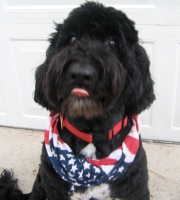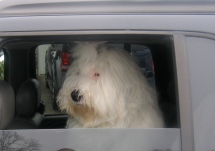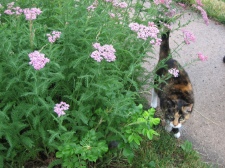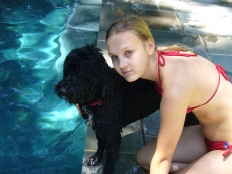You are currently browsing the monthly archive for July 2011.
“I like a dog at my feet when I read, Whatever his size or whatever his breed.” Edgar A Guest, American (b. England) 1881-1959
It is early Sunday morning and my dog, Hooper, is fast asleep at my feet as I write so I thought the above quote was especially appropriate for this “guest” blog post by Veterinarian, Dr. Patrick Mahaney of Los Angeles. Patrick requested to review my book and I really appreciate this, but as he is a doctor and gravitates toward Non-Fiction for the books he reviews for his Blog, (not that he doesn’t enjoy Fiction), I wondered how he would handle this. I really enjoyed how he “examined” the animal characters, seeing them through a vet’s eyes, without compromising the emotional heart of the stories. He will present two more parts of his review and I can hardly wait to learn of his diagnosis for the other five “tails!” Thank you Patrick…
Lisa Begin-Kruysmans Somethings Lost and Must Be Found: Six Short Tails of Inspiration on a Long Leash is an intriguing collection of stories profiling the familiar and otherworldly relationships between people and companion animals. In reviewing the tales, my scientific…read more via link below and check out Dr. Pat’s adorable Welsh terrier, Cardif!….
via Dr Mahaneys Book Review- Somethings Lost and Must Be Found by Lisa Begin-Kruysman Part 1.
 “The battle for the kind heart is never won; it must be fought steadily with every child, with every person with every new generation.” Captain William Lewis Judy – Founder of National Dog Week
“The battle for the kind heart is never won; it must be fought steadily with every child, with every person with every new generation.” Captain William Lewis Judy – Founder of National Dog Week
http://www.amazon.com/Somethings-Lost-Must-Found-ebook/dp/B0051ZMYG2/ref=sr_1_1?ie=UTF8&m=AG56TWVU5XWC2&s=digital-text&qid=1310214977&sr=1-1 My Short Story Collection continues to do nicely over on Amazon…Thanks for reading and the great five-star reviews. Next week, I will present the newly added seventh story in its entirety here on this site (a Writer’s Digest competition Honorable Mention) . SOMETHING’S LOST AND MUST BE FOUND now has 21 Five-Star reviews and will be the Book-of-the-Day on Amazon on December 5th! Watch for more exciting news.
…Lisa, WHO do we bug to get this going for those of us in the stone age that dont have tech readers yet. That kindle money has been set aside, and used for other things, saved up, set aside, used again for dog things, saved up, spent on better dog food…..sigh Wait, my BRAIN has been lost and must be found… a Comment from a potential reader! Thank you, I am working on this…
In a blog post of May 15th, I presented an interview with Thomas Cole of Shelter Revolution. Thomas discussed the challenges he faces when explaining his concept of communal living models as a remedy for our failing shelter system. Shelter Revolution promotes a healthier more natural way of housing homeless animals, letting them live and play in groups (in a carefully monitored and orchestrated manner) making for well-adjusted and happy pets that are more likely to find a forever home. Shelter Revolution is a new concept to many, one that invites lively discussion among animal-lovers so I encourage your comments and welcome questions so that more can be learned. I established this blog to encourage a positive exchange of ideas about all sorts of issues affecting dogs, and I am glad that it does.
Hopefully, with more emphasis on Spay and Neuter efforts, we might be able to lower the number of displaced animals in America, and by “managing” a smaller population of homeless pets in a more humane and positive way, we can see less suffering in the world, for both animal and the humans who love them.
Dog Trainer, Robert Cabral, of Malibu, California has found a way to use his Martial Arts background to train and socialize dogs. He also embraces new ways of looking at how shelter dogs are housed, like those proposed byThomas Cole’s Shelter Revolution Model. Upon hearing that I was writing a post about Robert, Ed Boks, Executive Director at Yavapai Human Society in Prescott, Arizona commented, “I’ve worked with many trainers over the past 30 years, from the famous to the ridiculous. Robert is the real deal. His methods transform unruly, even dangerous, shelter dogs into responsive companion animals. For shelters looking for alternatives to killing dogs for behavioral reasons, I recommend Robert Cabral.”
The following is my interview with Robert:
Can you tell us a little about yourself and how you “went to the dogs?” I rescued my first dog almost 8 years ago. When I brought him home I didn’t know much about training dog, but I knew how to teach karate. I wondered if using the teaching skills of the martial arts would apply to dogs, and it did. I never taught dogs to punch or kick, but I used a very fundamental approach to teaching my dog(s) what was right and wrong and they learned. Throughout the years I’ve seen this system work on every dog I’ve dealt with from obedience to aggression (fear and dominance based) as well as desensitization and a host of other issues. I began working with rescues, shelters as well as private clients; often times getting the dogs no one else wanted to deal with.
Robert, I “discovered” you after watching a video about a dog named Snowflake that was posted on the Shelter Revolution’s Facebook page. Can you tell us why you made this video and the message you wish to impart? Snowflake was one of those typical dogs that “falls through the cracks.” She had some behavioral issues, namely barking and growling at her kennel door. Understanding this behavior and dealing with it is quite simple, but people usually approach it in the wrong fashion. Snowflake had been abused and was covered in specks of white paint, that’s why I named her Snowflake. I believe in making the most of the positive and Snowflake had a lot of great attributes. We were able to get her rescued after showing that her kennel issues were just that, kennel issues. Whoever put her in the place that ended her up in the kennel is responsible for her issues – not Snowflake.
Groups like Shelter Revolution call for reform in the way shelter animals are housed. They promote the concept of Communal Living for our pets. Do you think this can work?
I’ve always been an advocate for at the very least doubling dogs in the kennels at shelters. This has many benefits: it increases a dog’s social skills, saves space and eases the stress of being isolated in shelters. I believe social kenneling can work, but there will be some issues including fights and more – however I think it’s worth the trade-off. Done properly, this is one of our greatest hopes for solving this crisis.
What needs must be addressed to make this possible and successful? As I mentioned above, this change won’t be without its downsides, but they are far fewer than the millions of animals that we are killing now. Establishing pack order will be important and I believe this should be handled by people who are skilled in dealing with this, not just rescue volunteers. This aspect should be taken very seriously. People need to understand that dogs are pack animals and need to be worked into the environment. Dogs will survive and I think we owe it to the dogs to see who is best suited and who is not suited to being placed into this environment. Some dogs should not be put into this situation until they are ready, for example fearful dogs, dominant dogs, sick dogs and old dogs and puppies.
There are those out there who say Communal Living is not a good idea, it cannot work. What do you say to them? Dogs are pack animals…get a clue!
What are the major issues concerning dogs, and dog-ownership, facing your region of the nation? The same concerns that plague Los Angeles plague the rest of the country and world. Ignorance on canine behavior patterns are at the forefront. Until people understand how dogs act and think, they think they need. They should reconsider their choice of pet. I’d rather see much fewer people owning dogs and see those dogs placed with responsible owners…not people who think they’re stuffed animals or a badge for their bravado. Dogs are living, sentient beings that we must strive to understand. We must give them what they need, not what we need.
I thank Thomas and Robert for trying to implement positive change. I am sure we will hear from them again To learn more about Robert and his work:
“Rambunctious, rumbustious, delinquent dogs become angelic when sitting.” Ian Dunbar, 1947
Five years ago today, the dogs of the nation, and their humans, lost a very good friend with the passing of Captain Arthur Haggerty, the “Grandfather of American Dog Obedience” and staunch supporter of the National Dog Week Movement. On this most patriotic of holidays, we can honor his memory with the fair and humane treatment of dogs (and all animals) everywhere.
Welcome Handsome Hardee, from Las Vegas, NV, our Dog of the Week on the National Dog Week Community Page. This page will feature some of the special dogs that have been part of our Blog’s 111 posts! Go on over and LIKE us and watch for new updates! http://www.facebook.com/about/login/#!/pages/National-Dog-Week/218596591491974
SOMETHING’S LOST AND MUST BE FOUND climbed the chart and remains #9 Top Rated in Amazon’s Animal Care and Health Category. Now with a seventh story that won an Honorable Mention in a Writer’s Digest Competition. http://www.amazon.com/s/ref=nb_sb_ss_i_0_33?url=search-alias%3Ddigital-text&field-keywords=somethings+lost+and+must+be+found&sprefix=somethings+lost+and+must+be+found
It was a dark and stormy…morning. Up in my writer’s loft, I blogged away while Hooper, my loyal dog, dozed peacefully on the couch. Suddenly the silence was shattered; once again, that dastardly woodpecker drilled away at our house like a jack hammer. Hooper flew into action, barking and circling. “Let’s get him, Mom,” she growled, bravely heading for the door. But the roar of thunder drove her back, shaking and trembling at my feet. And thus, another day of distractions, courtesy of Mother Nature, had begun.
Some authors take their “mews” in the feline form (Twain, Hemingway). But many I know look to a muse of a more canine-kind for their inspiration. It does seem that many writers work with a dog at their feet. Last August, I was contacted by blogger/writer Marshal Zeringue. He asked if I would be interested in talking about Every Dog has its Week on his blog, Coffee with a Canine. Hooper and I obliged and we were very happy when he again sought us out upon the release of Something’s Lost and Must be Found, a Short Story Collection inspired by this blog.
Many creative types get lost in their work. It can be a solitary life; creative efforts usually require a quiet and reclusive environment. A dog, cat, or other pet, reminds us that (gasp) life is going on around you. We need to take a break, be aware of others, and take the time to focus and care about those who need us most. A good pet can do all of that, asking so little in return.
Enjoy your life, family, friends and freedom on this Fourth of July Weekend!
Please enjoy the following interview with blogger and writer, Marshal Zeringue:
Can you tell us a little about your background? I’m a former academic who now spends most of my time writing, re-writing, fine-tuning (over and over again) as-yet-unproduced screenplays as well as tending to a number of blogs. I was born and partly educated in New Orleans, went to graduate school at the University of Virginia, then stayed in Virginia to teach. I’m now somewhat nomadic but find myself in south Louisiana more often than not.
We hear you write and moderate three blogs, what are they? The blog count is actually greater or smaller than three, depending on how you tally these things. I’ll explain: Coffee with a Canine is a blog more or less independent of my oldest blog, Campaign for the American Reader. So one might count that as two blogs. But CftAR is the hub for a network that includes The Page 69 Test, My Book, The Movie, The Page 99 Test, Writers Read, Lit Lists, Author Interviews, HEPPAS Books, and New Books.
I’ve actually got plans for a few more CftAR-related sites (and an idea for another canine/food-related blog) but I’m trying to resist.
As we’re all about dogs here, please tell us about Coffee with a Canine. When and why did you start it? Are all your subjects writers or in the arts? Two influences led to Coffee with a Canine, each independent of the other but both hit at about the same time. One, I noticed that a great many of the authors who helped with content for CftAR posts mentioned their dogs in the bio on their websites. At about the same time, I realized that the clear majority of my 10 or 12 closest friends had dogs.
It’s actually coincidental that so many of the blog guests are writers. More on that below.
How do you find the people you interview? Many of the interviewees are authors with dogs. This has, understandably, led many blog visitors to infer that CwaC is yet another of my lit related blogs. But being a writer is not a prerequisite for an interview. I’m actually interested in having dog-lovers from all walks of life on the blog. So I troll around the blogs to see if interesting bloggers have dogs. Also, I’m hoping to soon start visiting coffee shops and parks with my camera and recorder so that I can interview some dog-lovers in person.
What is the coffee connection? Mostly accidental. I wanted to build the Q&As around an event, but nothing too demanding or that required a lot of planning…or even leaving the house. So I ask the interviewee to plan a “coffee-date”–even though any beverage will do. I really do like the interviews that involve a visit to a cafe (New Orleanians as much as anyone like food and drink with their conversation); that’s one spur to the plan to get out there and do some in-person interviews at coffee-shops.
Thank you Marshal for taking time to share with us. I don’t know how you manage three blogs, one is challenging enough! I hope we get to see some of these taped events. We will definitely follow-up as this new idea brews.
















